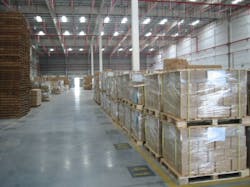For starters, let’s recognize that even though U.S. economic activity remains tepid – even after escaping the rough clutches of Old Man Winter – with a tight lid on trucking capacity, even a mediocre uptick in shipment volumes could create the right conditions for carriers to gain significant and sustained rate increases.
Let’s look at some economic data first. Lindsey Piegza, chief economist with Wall Street firm Sterne Agee, noted back at the start of April that while the Institute for Supply Management’s (ISM) manufacturing index rose slightly from 53.2 to 53.7 in March, the six-month average fell from 55.1 to 54.7, meaning that spring certainly didn’t come roaring in like a lion where factory activity is concerned.
“Winter weather was widely cited as the cause for the activity slowdown in recent months. But more temperate March conditions have hardly resulted in the activity rebound expected now that snow and ice storms are behind us,” Piegza explained in a research update. “This suggests it was more than weather repressing activity. More likely uneven domestic demand and tepid international demand have also been key, long term factors dampening manufacturers' production plans particularly amid a sizable inventory stockpile still overhanging from the fourth quarter.”
In the details, Piegza added that production rose from 48.2 to 55.9, new orders improved from 54.5 to 55.1 and the backlog of orders increased from 52.0 to 57.5 in March. New export orders also improved from 53.5 to 55.5 and imports grew from 53.5 to 54.5 in March.
And yet freight shipments – and more importantly, freight expenditures – increased in March, according to Cass Information Systems.
The Cass Freight Index – put together by Rosalyn Wilson, senior business analyst with Delcan Corp. and author of the annual State of Logistics report – indicated that shipment volume and total freight payments continued to climb in March, ending the first quarter of the year on a high note. And though bad weather continued to plague many parts of the country in March, transportation seemed to be less affected than in January and February.Cass' data indicated that March shipment volume increased 6.6% over February, on top of the 7.3% witnessed in February over January. Railroad carloads rose fairly steadily throughout March, up over 5%, while intermodal loadings increased over 3% and truck traffic picked up, according to the firm’s data
Wilson (seen above, speaking at last year's State of Logistics event) noted that factory production “has finally turned the corner” and is no longer contracting; rising almost 16% in March, which is the largest month‐to‐month increase since July 2009. New orders, a bellwether of future freight, rose again in March, up 1.1%, after plunging dramatically just two months ago. The backlog of orders jumped 10.6%, another indicator that freight volumes should be growing in coming months, she indicated.
More broadly, freight volumes in the first quarter were up over 10% compared to the fourth quarter of 2013, showing the strongest start of the last few years, though Wilson cautioned that it “remains to be seen” whether the number of shipments will follow the trends of recent years and falter in the second quarter.
In terms of money, though, freight expenditures increased for the second month in a row, rising 5.4% over February and though expenditures rose at a slower rate than volumes – indicating that most of the increase can be attributed to the change in volume – Wilson’s analysis noted that this is the second highest point the payments index has reached in four years, and 5.3% higher than in the same month in 2013.
“Manufacturing and production have turned a corner and are back in expansion mode [with] strong new orders and backlog figures bode well for the freight sector,” Wilson noted in her analysis. “Imports were up in February, especially for autos and parts. Sales of cars and pickup trucks – which are considered a harbinger of recovery in the construction sector – rose sharply in March. New housing starts actually fell for the first two months of 2014, but permits were up 5%.”
She added that the rough winter weather affected consumer spending during the first quarter as well, so expect to see recovery as consumers spend more because of pent-up demand.“All in all, lots of strengthening in the economy, but taking everything into consideration the signals are still mixed,” Wilson cautioned. “It will be interesting to see if we can continue to climb up or if we will keep with the trend of recent years and stumble in the second quarter.”
Yet in keep in mind that as the debate over the direction and strength of the U.S. economy continues apace, truck capacity is pretty much tapped out – meaning it won’t take much if any uptick in economic activity for a significant shortage to develop.
A recent first quarter analysis by Wall Street firm Stifel Nicolaus & Co. reiterated that the TL sector in particular lost 20% of capacity during the downturn, with 15 of those percentage points due to fleet downsizing and due to bankruptcies, liquidations, and repossessions. The company also thinks trucking productivity dropped anywhere from 2% to 4% as a result of hours of service (HOS) rule changes made last July.
Stifel also noted that most carriers otherwise are not adding capacity, except for those tied to specific dedicated fleet contracts, so that supply and demand is now roughly in balance despite tepid economic growth and excluding the disruptive impact of the much aforementioned wicked winter weather.
Still, the firm thinks there still may not be enough capacity reduction to support sizeable rate increases yet, as the likely culprits are the sub-potential economic recovery and supply chain optimization. That being said, though, Stifel thinks major capacity shortages are in the “possible-to-likely” range by 2016 and beyond.
Near term, though, the firm is witnessing what it calls “price increases in exchange for capacity commitments” and such deals should become more widely available as supply/demand tightness further intensifies, Stifel noted – adding that this “renewed focus” on dedicated deals to lock-in base load capacity is intensifying competition among shippers.What’s that mean in terms of freight numbers?
Well Stifel is seeing general contract TL rates rising about 2% to 4% year-over-year in the first half of 2014, with general dedicated TL rates up 1.5% to 3.5% year-over-year during the same time period – though the firm stresses those numbers could “prove to be conservative going forward” if the supply/demand equation further tightens.
Data tracked by research firm FTR Transportation Intelligence seems to back that analysis up on the shipper side of the freight ledger, as that firm’s Shippers Conditions Index (SCI) for February registered a negative reading of 8.8, reflecting what FTR dubs an “earlier than normal” tightening of capacity created by the debilitating effects of winter storms in early 2014.
Jonathan Starks, FTR’s director of transportation analysis, noted in a statement that conditions are expected to improve from this low point if a slowing of freight growth persists. However, FTR thinks shippers are advised to acquire sufficient capacity until after the spring seasonal shipping peak as 2014 may be a very volatile year requiring increased shipper attention to market conditions.
“Most of the components in the SCI are only slightly negative – freight, costs, and fuel – so the main drag comes from the very tight capacity situation that was highlighted this winter,” Starks said.
“This is a year to closely monitor signs for an economic uptick because it could have quick impacts on the transport sector,” he stressed. “If the economy stays stuck in slow-growth mode and the weather finally behaves, we can expect the extremely tight capacity to normalize by mid-summer. If, however, we can finally get some additional economic activity, especially in the vital manufacturing sector, the tight truck environment will persist and could significantly worsen. Now is a time for careful planning for the quickly approaching fall shipping season.”
Will trucking be picking some ripe freight apples this season? We’ll find out soon.







